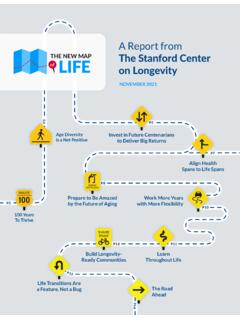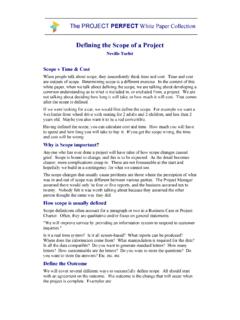Transcription of THE SCOPE OF THE PROBLEM - Stanford University
1 THE SCOPE OF THE PROBLEMAN OVERVIEW OF FRAUD PREVALENCE DeevyMichaela Beals 2013 The SCOPE of the PROBLEM | An Overview of Fraud Prevalence Measurement3 LETTER FROM THE DIRECTORI ndividualsGroupsGovernmentVoting fraudMarriage fraudImmigration fraudDear Colleagues, Launched in 2011, the Financial Fraud Research Center (FFRC) is a collaboration between the Stanford Center on Longevity and the FINRA Investor Education Foundation. This initiative grew out of a meeting of experts who gathered at the Stanford Center on Longevity to discuss the devastating impact of financial fraud. Acknowledging that the field could benefit from greater collaboration, the group was interdisciplinary with representation from academia, regulatory agencies, practitioners, and policymakers. The Financial Fraud Research Center uses a three-pronged approach to advance the fight against financial fraud: We consolidate research and information in accessible language.
2 We connect research to practice through events, publications, and other initiatives. We catalyze further research through seed focus of the FFRC is individual consumer victimization. Measuring and preventing fraud that targets organizations or governments (such as embezzlement, corruption, and tax evasion) is the express purpose of several other organizations. Our resources are dedicated to understanding, detecting, and preventing consumer-targeted scams: what we term consumer financial fraud, defined below. In 2012 we released the Center s initial survey document, Scams, Schemes, and Swindles: A Review of Consumer Financial Fraud Research. This report provided a broad outline of what we know (and what we have yet to learn) about consumer financial fraud its prevalence, victims, perpetrators, and methods with the intention to expand each section in forthcoming reports.
3 This report, The SCOPE of the PROBLEM : An Overview of Fraud Prevalence Measurement, takes a closer look at the question of fraud prevalence. Without accurate and reliable estimates of fraud, it is difficult to understand what works or does not work to protect victims from harm. Unfortunately, current estimates of fraud prevalence vary widely, making it difficult for law enforcement, researchers, and policymakers to appreciate the true SCOPE of the PROBLEM . Non-monetary gainFraudMonetary gaina misrepresentation or concealment of some fact material to a transaction of goods, services, or other benefits that is made with knowledge of its falsity, non-existence, or misrepresentation and with the intent to deceive another and that is reasonably relied upon by the other who is injured thereby (Titus et al., 1995).Consumer FraudInsurance fraudEmployee fraudTax fraudWelfare fraudStamp fraudMedicare fraudforinflicted upon4 Financial Fraud Research Center | report aims to reconcile the variability of financial fraud prevalence estimates, to explain why it is so difficult to obtain reliable and valid estimates, and to suggest ways to improve fraud prevalence measurement.
4 Specifically, this report: Places fraud prevalence research within the broader context of criminology and victimology research to see what we can learn from these fields. Provides an overview of the various methods and organizations that measure victimization in general, and fraud victimization in particular. Places fraud prevalence research within the broader context of survey methodology research to discuss how scientific advances in research and analysis can be used to improve the design of fraud surveys. Identifies ways to increase the validity and reliability of fraud prevalence measures, and outlines areas for future hope that this report will provide an informed foundation to the issue of fraud prevalence, will serve to connect practitioners and researchers, and will identify clear research directions surrounding consumer financial fraud measurement.
5 We encourage you to share your thoughts and responses to this white paper with us directly and to explore additional resources online at DeevyDirector, Financial Fraud Research CenterThe SCOPE of the PROBLEM | An Overview of Fraud Prevalence Measurement5 TABLE OF CONTENTSLETTER FROM THE DIRECTOR 3 EXECUTIVE SUMMARY MEASUREMENT PREVALENCE FROM OTHER CRIME 35 CONCLUSIONS & RECOMMENDATIONS 41 REFERENCES 43 The SCOPE of the PROBLEM | An Overview of Fraud Prevalence Measurement7 EXECUTIVE SUMMARYT here is no question that financial fraud is a pressing concern. With billions of dollars in losses impacting an estimated tens of millions of victims, fraud is a major PROBLEM ( Anderson, 2013). But the wide range of fraud prevalence estimates makes it difficult for law enforcement, practitioners, and policymakers to assess the true SCOPE and impact of the PROBLEM .
6 Section I of this report provides the context and methodological background necessary for evaluating fraud prevalence measurement. Specifically, this section describes the traditional methods of measuring incidence and prevalence with a particular emphasis on survey methodology and outlines the organizations that measure crime generally and fraud sum, there are two primary sources of data for victimization prevalence and incidence estimates: 1) self-report complaint data from agencies; and 2) data from surveys. The former counts actual incidents of fraud that were reported to authorities, while the latter estimates victimization on the national scale based on the experience of a surveyed sample. Fraud victimization has historically been overlooked in the greater criminology and victimology literature. Indeed, the two sources of official crime statistics in the United States, the FBI s Uniform Crime Report (agency data), and the National Crime Victimization Survey (survey data), both largely ignore fraud victimization.
7 Thus, data used to assess the prevalence of fraud come from other organizations or surveys that address fraud II describes the range of fraud prevalence and cost estimates found in seminal and recent studies. This section illustrates how analyzing data sources and survey methodology helps explain variable prevalence estimates. Issues of fraud under-reporting and under-admitting are also addressed in this section. In short, fraud prevalence estimates vary widely. Complaint data, though increasing over time, still vastly underestimate the SCOPE of the PROBLEM due to the large number of victims who do not report to authorities. Surveys are therefore the most common method of collecting prevalence data. Yet victimization rates vary even among surveys. This is due to a variety of factors, including different sample populations, different prevalence periods, different definitions of fraud, and different question measures rely on the accuracy of individuals self-reports and on their willingness to share information with interviewers.
8 Surveys about victimization are at a particular disadvantage because respondents may not want to discuss stigmatizing or traumatic events. This makes it especially important to understand how survey design elements can influence obtained rates of III describes what we can learn about prevalence measurement from other crimes. Indeed, fraud is not the only crime that is difficult to quantify. We can look to the history of addressing issues of measurement in other crime domains, such as rape, missing children, and elder abuse, to learn valuable lessons about encouraging reporting. Placing fraud within the broader context of victimology and survey methodology research helps us understand the current limitations of fraud prevalence estimates, and provides direction for how we might increase the accuracy of measurement in the future. The SCOPE of the PROBLEM | An Overview of Fraud Prevalence MEASUREMENTG uiding Questions: What are the traditional methods of measuring incidence and prevalence?
9 What are the advantages and disadvantages of each method? What are the different types of surveys? What are potential sources of bias in survey data? What organizations measure victimization in general, and fraud victimization in particular? How do they collect their data?Section Summary: There are two primary sources of data concerning victimization prevalence and incidence: 1) complaint data from agencies and institutions, and 2) data from surveys that ask participants about their experience with victimization. When analyzing prevalence data, it is important to consider the source of the data and what the numbers truly mean. If a study reports complaint data, for example, then the numbers constitute actual incidents of victimization that were reported to, and counted by, authorities. If the national number of incidents comes from a survey, the number is an estimation based on the experience of the sample population.
10 Furthermore, the incidents of fraud counted in surveys include both those that were reported to authorities and those that went unreported. Since so many incidents of victimization are not reported to authorities, estimates of national victimization from surveys are much larger than the number of cases reported to authorities and included in complaint data counts. This is not an inherent failing on the part of agency data, but reflects the different purpose of data collection. Surveys are the most common method used to collect prevalence data regarding fraud victimization. The reliability and validity of surveys are affected by both the quality of the survey and the quality of the respondents answers. Fortunately, well-designed surveys can mitigate many of the cognitive biases that lead respondents to offer less-than-thoughtful or inaccurate response. The two main sources of official crime statistics in the United States both largely ignore fraud victimization.










